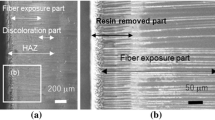Abstract
Laser machining has great potential for automated manufacturing of parts made of carbon-fiber-reinforced plastic (CFRP) due to the nearly force and tool-wear free processing. The high vaporization temperatures and the large heat conductivity of the carbon fibers, however, lead to unintentional heat conduction into the material causing damage in zones close to the process. In this paper, the matrix damage zone (MDZ) is subdivided into a matrix sublimation zone (MSZ) where the matrix material was sublimated and a zone where the temperature temporarily exceeded a value causing structural damage in the matrix. In order to investigate the extent of these zones, a one-dimensional heat flow model was applied, which was calibrated by cutting experiments using temperature sensors embedded in the CFRP samples. The investigations showed that the extents of the MSZ and MDZ are dominated by a total interaction time, which includes the passage of the laser beam and the continued interaction of the cloud of hot ablation products with the carbon fibers at the kerf wall and that from a practical point of view, the experimentally determined effective heat conductivity is suitable for simple estimations of the heat-affected zones in CFRP.











Similar content being viewed by others
References
G.W. Ehrenstein, Faserverbund-Kunststoffe. Werkstoffe – Verarbeitung – Eigenschaften, Hanser (2006)
G. Caprino, I. De Iorio, L. Nele, L. Santo, Effect of tool wear on cutting forces in the orthogonal cutting of UD GFRP, composites part A. Appl. Sci. Manuf. 27A, 409–415 (1996)
K.C.A. Crane, J.R. Brown, Laser-induced ablation of fibre/epoxy composites. J. Phys. D Appl. Phys. 14, 2341–2349 (1981)
M. Jahrwitz, V. Onuseit, R. Weber, T. Graf, Spectral analysis of laser processing of carbon fiber reinforced plastics. Phys. Procedia 41, 489–494 (2013)
P. Mucha, N. Speker, R. Weber, T. Graf, Momentum and velocity of the ablated material in laser machining of carbon fiber preforms. Appl. Phys. A 113, 361–366 (2013)
A. Narazaki, T. Sato, Y. Kawaguchi, H. Nino, Laser ablation of carbon fiber reinforced plastics: laser-ionization TOF mass spectrometric study. in Proceedings of LAMP (2013)
T.M. Young, Impact of Nd-YAG laser drilling on the fatigue characteristics of PC-2A/AS4 thermoplastic composite material. J. Thermoplast. Compos. Mater. 21, 543 (2008)
J.P. Davim, N. Barricas, M. Conceicao, C. Oliveira, Some experimental studies on CO2 laser cutting quality of polymeric materials. J. Mater. Process. Technol. 198, 99–104 (2008)
Z.L. Li, P.L. Chu, H.Y. Zheng, G.C. Lim, Process development of laser machining of carbon fibre reinforced plastic composites. in Proceedings of ICALEO (2008), pp. 222–231
P. Moreno, C. Méndez, A. García, I. Arias, L. Roso, Femtosecond laser ablation of carbon reinforced polymers. Appl. Surf. Sci. 252, 4110–4119 (2006)
J. Mathew, G.L. Goswami, N. Ramakrishnan, N.K. Naik, Parametric studies on pulsed Nd:YAG laser cutting of carbon fibre reinforced plastic composites. J. Mater. Process. Technol. 89–90, 198–203 (1999)
W. M. Haynes, CRC Handbook of Chemistry and Physics, 94th edn. (Taylor and Francis, New York, 2013)
C. Sheng, G. Chryssolouris, Theoretical model of laser grooving for composite materials. J. Compos. Mater. 29, 96–112 (1995)
A. Goeke, C. Emmelmann, Influence of laser cutting parameters on CFRP part quality. Phys. Procedia 5, 253–258 (2010)
F. Abedin, Review on heat affected zone (HAZ) in laser machining. in Proceedings of the 6th annual GRASP symposium, Wichita State University (2010)
P. Jaeschke, M. Kern, U. Stute, D. Kracht, H. Haferkamp, Laser processing of continuous carbon fibre reinforced polyphenylene sulfide organic sheets—correlation of process parameters and reduction in static tensile strength properties. J. Thermopl. Compos. Mater. 27(3), 324–337 (2014). doi:10.1177/0892705712446016
R. Weber, M. Hafner, A. Michalowksi, T. Graf, Minimum damage in CFRP laser processing. Phys. Procedia 12(2), 302–307 (2011)
S. Bluemel, R. Staehr, P. Jaeschke, U. Stute, Determination of corresponding temperature distribution within CFRP during laser cutting. Phys. Procedia 41, 401–407 (2013)
C. Jaeger, Conduction of Heat in Solids, 2nd edn Hrsg. (University Press, Oxford, 1959), pp. Chap. X §10.7, IX
D. Herzog, P. Jaeschke, O. Meier, H. Haferkamp, Investigations on the thermal effect caused by laser cutting with respect to static strength of CFRP. Int. J. Mach. Tools Manuf 48, 1464–1473 (2008)
J. Stock, M.F. Zaeh, M. Conrad, Remote laser cutting of CFRP: improvements in the cut surface. Phys. Procedia 39, 161–170 (2012)
A. Wolynski, T. Herrmann, P. Mucha, H. Haloui, J. L’Huillier, Laser ablation of CFRP using picoseconds laser pulses at different wavelengths from UV to IR. Phys. Procedia 12, 292–301 (2011)
Acknowledgments
This work was supported by the German Federal Ministry of Education and Research (BMBF) within the Framework Project “Research for Tomorrow’s Production” (FlexiCut, 02PJ2207) and managed by the Project Management Agency Karlsruhe (PTKA).
Author information
Authors and Affiliations
Corresponding author
Rights and permissions
About this article
Cite this article
Mucha, P., Berger, P., Weber, R. et al. Calibrated heat flow model for the determination of different heat-affected zones in single-pass laser-cut CFRP using a cw CO2 laser. Appl. Phys. A 118, 1509–1516 (2015). https://doi.org/10.1007/s00339-014-8932-z
Received:
Accepted:
Published:
Issue Date:
DOI: https://doi.org/10.1007/s00339-014-8932-z




